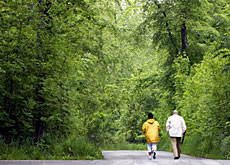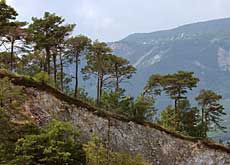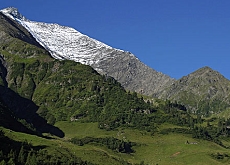Forests are healthy but suffer from stress

Swiss forests are generally in a good state despite regular cries of alarm, a new report has found.
They are growing in surface area every year but pollutants, dry weather, storms and bark beetles are sources of major stress for them.
The report, presented on Monday in Bern, was compiled by the Swiss environment agency and the Federal Institute for Forest, Snow and Landscape Research.
The authors of the report say there is no evidence that the existence of Swiss forests is at risk in the short term.
But even if there can no longer be talk of “dying forests”, deposits of atmospheric pollution are a risk in the long term.
More than 90 per cent of forests are exposed every year to too high concentrations of nitrogen coming from agriculture and exhaust fumes.
The situation is said to be particularly serious in low-lying areas, near the Alps and in the southern part of canton Ticino.
Growing forests
The 130-page report says forests are growing the size of Lake Thun (about 50 square kilometres) a year, mainly in the Alps.
The volume of wood is also growing, as timber is being less used and is gaining in age.
Willy Geiger, deputy director of the Swiss environment agency, recommended that forests should be replanted to protect roads and houses from avalanches, landslides or rock falls.
He also underlined the ongoing crisis in the timber industry, which represents 1.6 per cent of Swiss gross domestic product, similar to that of the watch industry.
A significant number of forest owners had been in the red since the 1980s as a result of the low cost of timber, high production costs and foreign competition, he explained.
About one in ten jobs in the sector had disappeared over the past six years.
Geiger argued that the report called for political action with improved general conditions for the sector and measures to make demand for timber higher.
For and against
In reactions to the report the association representing the timber industry, Lignum, welcomed the conclusions that wood was being underused in Switzerland and the sector was in a desolate state.
But the environment organisation, Pro Natura, said it opposed any liberalisation of the industry, arguing that this would not bring in much more income und would have harmful effects.
It said the biodiversity of Switzerland’s forests was in danger.
swissinfo with agencies
Forest area:
1.2 million hectares (30% of Swiss territory)
Ownership:
73% public forest
27% private forest
Timber growth:
9.8 million square metres per year
Employees forestry sector:
About 7,300 people
Timber sector:
About 73,400 people

In compliance with the JTI standards
More: SWI swissinfo.ch certified by the Journalism Trust Initiative


You can find an overview of ongoing debates with our journalists here . Please join us!
If you want to start a conversation about a topic raised in this article or want to report factual errors, email us at english@swissinfo.ch.